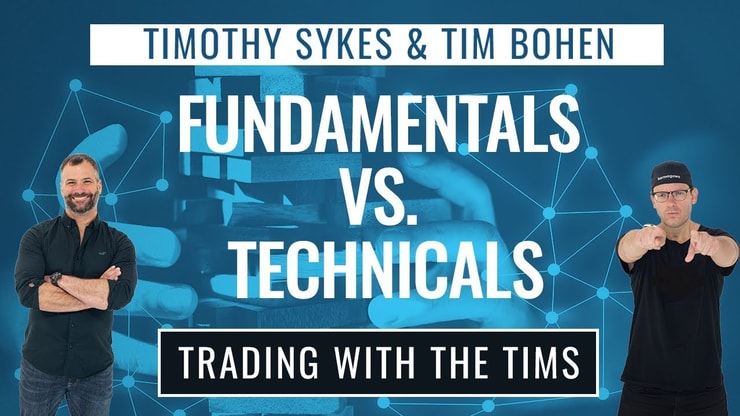When considering technical vs fundamental analysis, each trader’s approach can vary. Both are used at separate intervals to evaluate stock prices and potential future movements.
I use both.
So do all of my 30-plus millionaire students.
When it comes to which is better, that’s a difficult question to answer.
That’s because every trader is different.
There is a ton of opportunity to profit in the market. How a trader chooses to do that is up to them.
With that said … I’ve found a few rules are necessary for success in this niche.
I’ve traded for more than two decades. I’ve seen a lot of traders come and go. The reason most traders lose is that they don’t have the discipline to follow the rules.
If you made it this far, you might have what it takes.
But what I know for sure is that you need a healthy balance between technical and fundamental analysis.
Here’s how each can help …
Table of Contents
- 1 What Is Technical Analysis?
- 2 What Is Fundamental Analysis?
- 3 Differences Between Fundamental and Technical Analysis
- 4 Steps to Carry Out Fundamental Analysis
- 5 Steps to Carry Out Technical Analysis
- 6 Pros and Cons of Fundamental Analysis
- 7 Pros and Cons of Technical Analysis
- 8 Using Fundamental and Technical Analysis Together
- 9 Fundamental vs. Technical Analysis. Which is Better?
- 10 Key Takeaways
- 11 FAQs
- 11.1 When Should I Use Fundamental Analysis vs. Technical Analysis?
- 11.2 Can Fundamental and Technical Analysis Be Used Together?
- 11.3 What Are Some Advantages and Disadvantages of Fundamental Analysis?
- 11.4 What Are Some Advantages and Disadvantages of Technical Analysis?
- 11.5 What Are the Main Differences Between Technical and Fundamental Analysis in Terms of Market Data, Stock Prices, Strategies, and Investment Strategy? Can You Provide an Example?
- 11.6 How Do Finance, Accounting, Profits, and Returns Factor Into Technical vs Fundamental Analysis? What Role Does Interest Rates Play in These Analyses?
- 11.7 In Terms of Content, What Types of Articles and Sources Provide Quality Information on Technical vs Fundamental Analysis? How Do Industries and Sectors Differ in These Analyses, and What Is the Effect on Commodities?
- 11.8 What Is the Purpose and Objective of Using Technical vs Fundamental Analysis? How Do They Differ in Their Approach to Shares, Time Horizon, and Risk Assessment?
- 11.9 What Are the Rights and Responsibilities of Shareholders in Terms of Technical vs Fundamental Analysis? How Do These Methods Affect the Variety and Direction of Investments?
- 11.10 How Does Technical vs Fundamental Analysis Impact Asset Management, Gains, and People’s Investment Knowledge? What Are the Most Common Misconceptions and Analyst Opinions?
- 11.11 How Do Technical and Fundamental Analysis Interpret the Markets, Especially in Terms of Supply and Demand Dynamics?
- 11.12 What Role Do Wealth and Products Play in Selecting Between Technical and Fundamental Analysis for Investing? Is There a Case for Using Both in Unison?
- 11.13 How Do Different Investment Criteria and Results Affect the Choice Between Technical and Fundamental Analysis? Can These Analyses Be Applied to Credit Cards or Other Non-Traditional Investment Areas?
- 11.14 In the World of Investing, What Importance Does Duration and Buyers’ Behavior Have in the Application of Technical and Fundamental Analysis? How Does It Correlate With Market Highs and Lows?
- 11.15 What Significance Does Work Done on Managing Investment Accounts Have With Respect to Technical and Fundamental Analysis? How Does the Principal Invested Affect the Analysis’ Conclusion?
- 11.16 In What Scenarios Do Investors Run the Risk of Incurring Extra Cost When Applying Technical vs Fundamental Analysis? What Does It Mean When Companies Mention ‘Nothing’ in Kind as a Part of Their Investment Strategy?
- 11.17 How Do Technical and Fundamental Analysis Consider Different Investment Periods and Shareholders’ Interests? What Role Does the Principal Amount and Matter of Investment Preference Play?
What Is Technical Analysis?

2025 Millionaire Media, LLCTechnical analysis is a trading discipline that analyzes historical price action and market trends to predict future movements.
It’s all about charts, price trends, momentum, and patterns. The idea here is to identify opportunities based on historical price data and trading volume.
For traders who thrive on real-time insights and quick decisions, the technical analysis offers immediate feedback through charts and indicators. You watch the price action, analyze the trends, and make your move.
It’s less about the company’s profitability or the industry’s strength and more about what the price and volumes are telling you.
Understanding the nuances of technical analysis requires a deep dive into various indicators and chart patterns.
One such vital aspect is the MACD indicator, which helps in identifying the underlying momentum and trend direction. Learning how to use the MACD indicator effectively can enhance your trading strategy.
For those interested in exploring this further, I’ve detailed the MACD indicator and how to use it in a comprehensive guide. It’s a sober approach to understanding this powerful tool without any hype.
What Is Fundamental Analysis?
Fundamental analysis, on the other hand, takes a comprehensive view of a company’s financial health.
It analyzes balance sheet, income statement, market capitalization, and various financial ratios.
It seeks to identify the intrinsic value of a share, providing insights into the company’s long-term growth prospects and profitability.
Traders who follow this method are typically interested in the underlying business, industry dynamics, and economic indicators.
They are not swayed by short-term price movements but rather focus on long-term investment opportunities based on a company’s fundamentals.
But as I said earlier, I use both.
And if you’re truly interested in trading. You might have what it takes to join my Challenge.
It’s where I shared my trading process with my 30-plus millionaire students.
Some people don’t have the discipline. But there’s only one way to find out …
Differences Between Fundamental and Technical Analysis

2025 Millionaire Media, LLCWhen engaging with the stock market, two main methods are fundamental and technical analysis.
Fundamental analysis dives into a company’s financials, earnings, and overall health. It’s more about the intrinsic value of stocks, guiding long-term investment decisions.
Technical analysis, on the other hand, leans on chart analysis and historical price trends. It’s more about timing the market, guiding when to buy or sell.
Comparing Methodology of Fundamental and Technical Analysis
Technical analysis is about the “what” – what is the price doing, what patterns are forming, what do the indicators signal?
Fundamental analysis, conversely, is concerned with the “why” — why is the share price moving, why is the industry performing in a particular way, and why are the financial metrics showing these numbers?
I made a great video with lead trainer Tim Bohen that explores the topic even further.
I’ll link it below …
Tools Used for Fundamental and Technical Analysis
In technical analysis, charts and technical indicators like moving averages and trend lines form the backbone.
In contrast, fundamental analysis delves into financial reports, economic data, industry research, and company performance.
Steps to Carry Out Fundamental Analysis
Fundamental Analysis is a comprehensive study of a company’s overall financial health. It involves evaluating financial statements, equity levels, earnings, and more to determine a stock’s intrinsic value.
This information guides investors in making informed decisions on buying or selling shares.
More Breaking News
- Netflix Price Surge: A Golden Opportunity?
- Botala Energy’s Sudden Rise: What It Means
- LLY Stocks Surge: Breaking Down the Numbers
Perform Company Analysis
Start with an in-depth examination of the company’s financial statements, market position, and industry dynamics.
Look at earnings, balance sheet health, and liabilities.
Perform Financial Modeling
Build a financial model to understand how changes in the market, economy, and company-specific factors impact the share price.
Carry out Valuation Analysis
Valuation involves assessing the company’s value using various methods like Price-to-Earnings (P/E) ratios and Discounted Cash Flow (DCF).
Perform Discounted Cash Flow Analysis
DCF analysis helps in estimating the future cash flows of the company, discounting them back to present value.
Analyze Relative Valuation Analysis
Relative valuation involves comparing the company’s valuation with other firms in the same industry, assessing its market position.
Steps to Carry Out Technical Analysis

2025 Millionaire Media, LLCTechnical analysis focuses on analyzing stock charts, price movements, and market trends. It helps traders time their entry and exit points by studying historical data.
This is a very important aspect of technical analysis …
Traders in my niche NEED up-to-date data.
Free trading software displays data 10 – 20 minutes late. And it rarely allows broker integration or useful scanning capabilities.
Do you see the issue?
Successful trading requires tools with a certain degree of sophistication. That’s why I helped design StocksToTrade.
It has everything a small-account trader needs to surf highly volatile stock spikes.
Click here and try a 14-day StocksToTrade trial for just $7.
With the right tools and strategy, it facilitates short-term trades and helps in setting stop-loss levels.
Selecting the right tools and interfaces is a crucial step in technical analysis. Among these tools, the MACD settings play a significant role in fine-tuning your trading strategy. The best MACD settings can vary depending on your trading style and the market conditions.
If you’re looking to optimize your MACD settings for your specific needs, you can find a detailed explanation of the best MACD settings in my guide. It’s a straightforward resource to help you make informed decisions.
Identify the Best-Suited Strategy
Choose a technical trading strategy that aligns with your goals and risk tolerance, whether it’s trend-following, momentum, or mean reversion.
Select a Trading Account
Choose the right trading account that provides the necessary tools, interfaces, and support for your chosen strategy.
Know Your Tools & Interfaces
Familiarize yourself with the chart image, indicators, and platforms you’ll be using. Understand the functionality and how they aid your trading decisions.
In addition to familiarizing yourself with various charts and indicators, understanding specific tools like the Aroon indicator can be beneficial. The Aroon indicator helps in identifying trend changes and the strength of a trend. It’s a valuable addition to any technical trader’s toolkit.
If you want to delve into the intricacies of this indicator and how it can be applied to your trading strategy, you can explore my guide on the Aroon indicator. It’s a concise and practical resource to enhance your trading insights.
There’s a time and place for every indicator. The question is whether it fits into your strategy.
Always Paper Trade First
Before risking real capital, practice with paper trading to test your whole strategy without financial risk.
Set Stop Loss
A stop-loss order is a crucial tool in managing risk. Set it at a predetermined level to limit potential loss in adverse market conditions.
Always remember that trading is inherently risky.
A 2019 study called “Day Trading for a Living?” looked at the success rates of Brazilian traders over a 2-year window, and found that 97% of traders with more than 300 days of active trading lost money.
Only 1.1% earned more than the Brazilian minimum wage — that’s only $16 per day!
The $7.4 million I’ve earned over my 20-plus year trading career is proof that there are profit opportunities. I’ve done that by paying attention to risk, and cutting my losses quickly.
Pros and Cons of Fundamental Analysis

2025 Millionaire Media, LLCFundamental analysis comes with advantages such as providing a long-term perspective and an in-depth understanding of a company’s health.
However, it can also be time-consuming and prone to assumptions that might misguide investment decisions.
Advantages
Fundamental analysis offers a thorough understanding of a company’s financial situation and industry positioning. It looks beyond price movements to the underlying strengths and weaknesses.
Disadvantages
However, it’s time-consuming and requires a substantial understanding of financial statements, industry trends, and economic indicators.
Moreover, it may not always capture short-term price movements.
Pros and Cons of Technical Analysis
Technical Analysis is known for enabling quick trading decisions and being adaptable to various market conditions.
However, it also carries risks like misinterpretation of charts and trends, and it might overlook the essential fundamental aspects of a company.
Advantages
Technical analysis is immediate and reactive.
It enables traders to make quick decisions based on price action and chart patterns. It’s suitable for short-term trades where quick entry and exit are paramount.
Disadvantages
However, it may overlook broader industry trends and company health.
It’s susceptible to false signals, especially in volatile market conditions.
Using Fundamental and Technical Analysis Together
Combining these two methods can bring a balanced view, utilizing the strengths of both approaches.
I explain more in the video below …
While technical analysis guides the timing of entry and exit, fundamental analysis provides a broader perspective on the long-term potential and risks.
Fundamental vs. Technical Analysis. Which is Better?
Neither approach is universally better; the choice depends on your trading style, goals, and risk tolerance.
Maybe you thought about that possibility at the beginning … That’s a sign you might be right for this industry.
Short-term traders might lean towards technical analysis, while long-term investors may prefer the depth of fundamental analysis.
It varies based on individual cases.
Key Takeaways

2025 Millionaire Media, LLCTechnical Analysis focuses on charts, price trends, and historical data.
Fundamental Analysis delves into financials, industry trends, and economic indicators. A combination of both approaches can provide a comprehensive view of the market.
Your choice between these methods should align with your trading goals and risk profile.
Trading isn’t rocket science. It’s a skill you build and work on like any other. Trading has changed my life, and I think this way of life should be open to more people…
I’ve built my Trading Challenge to pass on the things I had to learn for myself. It’s the kind of community that I wish I had when I was starting out.
We don’t accept everyone. If you’re up for the challenge — I want to hear from you.
Apply to the Trading Challenge here.
Trading is a battlefield. The more knowledge you have, the better prepared you’ll be.
Do you use diamond pattern trading in your trading strategy? Let me know in the comments — I love hearing from my readers!
FAQs
When Should I Use Fundamental Analysis vs. Technical Analysis?
Use fundamental analysis for long-term investment decisions based on the company’s financial health and industry insights.
Use technical analysis for short-term trading, focusing on price action and patterns.
Can Fundamental and Technical Analysis Be Used Together?
Yes, combining both approaches can provide a comprehensive view, with technical analysis guiding timing, and fundamental analysis offering long-term perspectives.
What Are Some Advantages and Disadvantages of Fundamental Analysis?
Advantages include deep insights into a company’s financial health and long-term potential.
Disadvantages include time-consuming research and potential overlooking of short-term price trends.
What Are Some Advantages and Disadvantages of Technical Analysis?
Advantages include immediate insights into price trends and suitability for short-term trading.
Disadvantages include susceptibility to false signals and potential overlooking of broader industry trends and company fundamentals.
What Are the Main Differences Between Technical and Fundamental Analysis in Terms of Market Data, Stock Prices, Strategies, and Investment Strategy? Can You Provide an Example?
Technical Analysis primarily relies on market data, including stock prices, to determine potential future price movements.
It often employs various strategies based on past price patterns. Fundamental analysis, on the other hand, considers the investment strategy aligned with a company’s financial health, industry prospects, and overall economic conditions. An example of each approach can be found in various investment articles and courses.
How Do Finance, Accounting, Profits, and Returns Factor Into Technical vs Fundamental Analysis? What Role Does Interest Rates Play in These Analyses?
Finance and accounting principles are essential in fundamental analysis, where the focus is on understanding a company’s profits, returns, and overall financial health.
Interest rates can also be a critical factor, affecting valuations and investment decisions.
Technical analysis, however, may overlook these aspects, concentrating more on market patterns and price history.
In Terms of Content, What Types of Articles and Sources Provide Quality Information on Technical vs Fundamental Analysis? How Do Industries and Sectors Differ in These Analyses, and What Is the Effect on Commodities?
Several articles and sources offer quality content on technical and fundamental analysis, each focusing on various industries, sectors, and commodities.
Technical analysis might apply more universally across different sectors, while fundamental analysis may require specific knowledge about the particular industry or commodity in question.
The purpose and objective of technical analysis is to identify short-term price trends and trading opportunities. It often considers historical price patterns and shares volume.
Fundamental analysis, on the other hand, focuses on a longer time horizon and involves a thorough examination of a company’s intrinsic value, risk profile, and potential returns.
Shareholders often employ both technical and fundamental analysis to guide their investment decisions.
While technical analysis offers a variety of short-term trading options, fundamental analysis emphasizes the direction of long-term investment based on company fundamentals.
Both methods provide unique insights and complement the rights and responsibilities of shareholders in managing their investment portfolios.
How Does Technical vs Fundamental Analysis Impact Asset Management, Gains, and People’s Investment Knowledge? What Are the Most Common Misconceptions and Analyst Opinions?
Technical and fundamental analysis play crucial roles in asset management, influencing investment gains and informing people’s investment knowledge.
Analyst opinions may vary, with some favoring the quantitative nature of technical analysis and others preferring the qualitative insights of fundamental analysis.
Common misconceptions may include overreliance on one method or misunderstanding their application and purpose.
How Do Technical and Fundamental Analysis Interpret the Markets, Especially in Terms of Supply and Demand Dynamics?
Technical analysis examines the markets by focusing on historical price range and patterns, whereas fundamental analysis considers broader economic factors, including supply and demand.
The former may emphasize short-term fluctuations, while the latter looks at underlying reasons affecting market balance.
What Role Do Wealth and Products Play in Selecting Between Technical and Fundamental Analysis for Investing? Is There a Case for Using Both in Unison?
Wealth management may use a combination of technical and fundamental analysis, selecting various financial Products based on client needs.
The case for using both methods depends on investment goals, risk tolerance, and market conditions, allowing investors to leverage strengths of both approaches.
How Do Different Investment Criteria and Results Affect the Choice Between Technical and Fundamental Analysis? Can These Analyses Be Applied to Credit Cards or Other Non-Traditional Investment Areas?
Investment Criteria and desired results can shape the choice between these analyses.
While technical analysis may target short-term gains, fundamental analysis seeks long-term growth.
As for credit cards and non-traditional areas, these analyses typically focus on investable assets, not consumer finance products.
In the World of Investing, What Importance Does Duration and Buyers’ Behavior Have in the Application of Technical and Fundamental Analysis? How Does It Correlate With Market Highs and Lows?
Duration refers to the time horizon for investing, with technical analysis often used for shorter periods, focusing on buyers’ behavior and market highs and lows.
Fundamental analysis considers a longer duration, studying underlying company fundamentals and broader economic indicators.
What Significance Does Work Done on Managing Investment Accounts Have With Respect to Technical and Fundamental Analysis? How Does the Principal Invested Affect the Analysis’ Conclusion?
The work on managing investment accounts may differ between the two analyses.
Technical analysis may require frequent monitoring and adjustments, whereas fundamental analysis often involves deeper research into the principal investment.
The conclusion drawn from either method depends on investment goals, risk factors, and market dynamics.
In What Scenarios Do Investors Run the Risk of Incurring Extra Cost When Applying Technical vs Fundamental Analysis? What Does It Mean When Companies Mention ‘Nothing’ in Kind as a Part of Their Investment Strategy?
Investors may run into extra costs with technical analysis due to frequent trades and commissions.
Fundamental analysis might involve fees for in-depth research and advisory services. When companies mention ‘nothing in kind,’ it may refer to an approach devoid of non-monetary benefits or incentives in their investment strategy.
Technical and fundamental analysis cater to different investment periods, with the former targeting short-term gains and the latter long-term growth.
Shareholders’ interests and the principal amount invested can significantly matter in choosing the appropriate method, aligning with risk tolerance and investment objectives.











Leave a reply